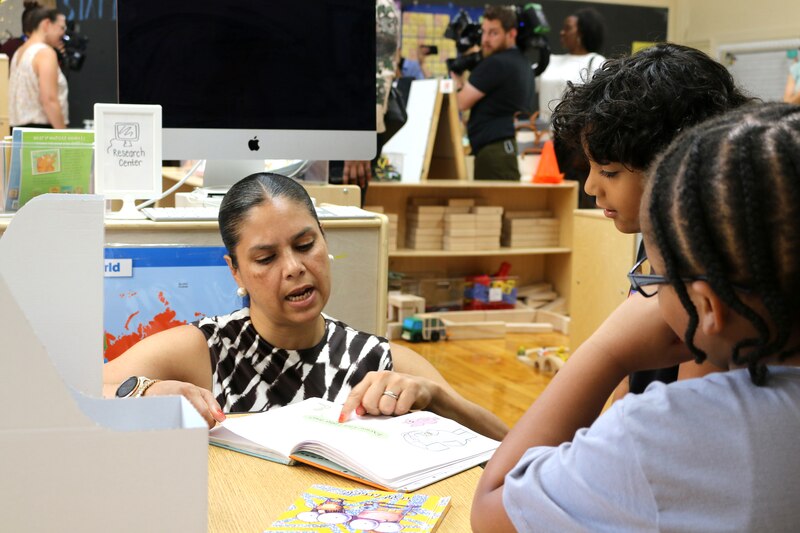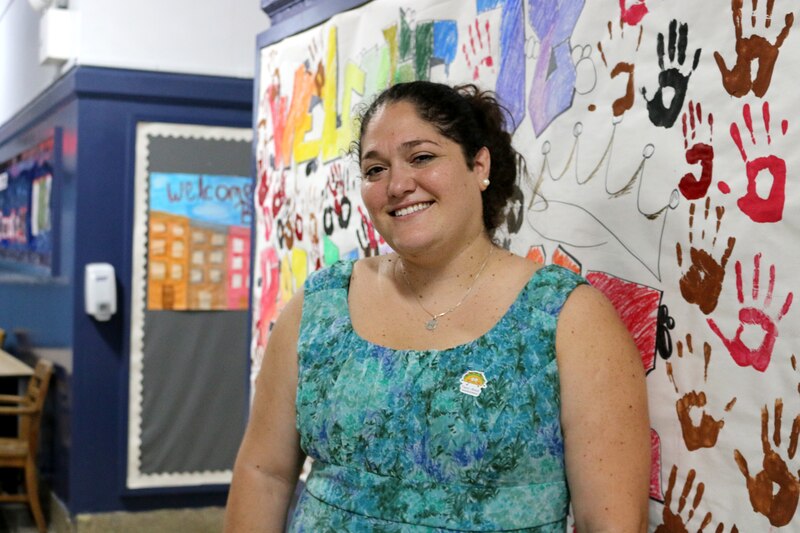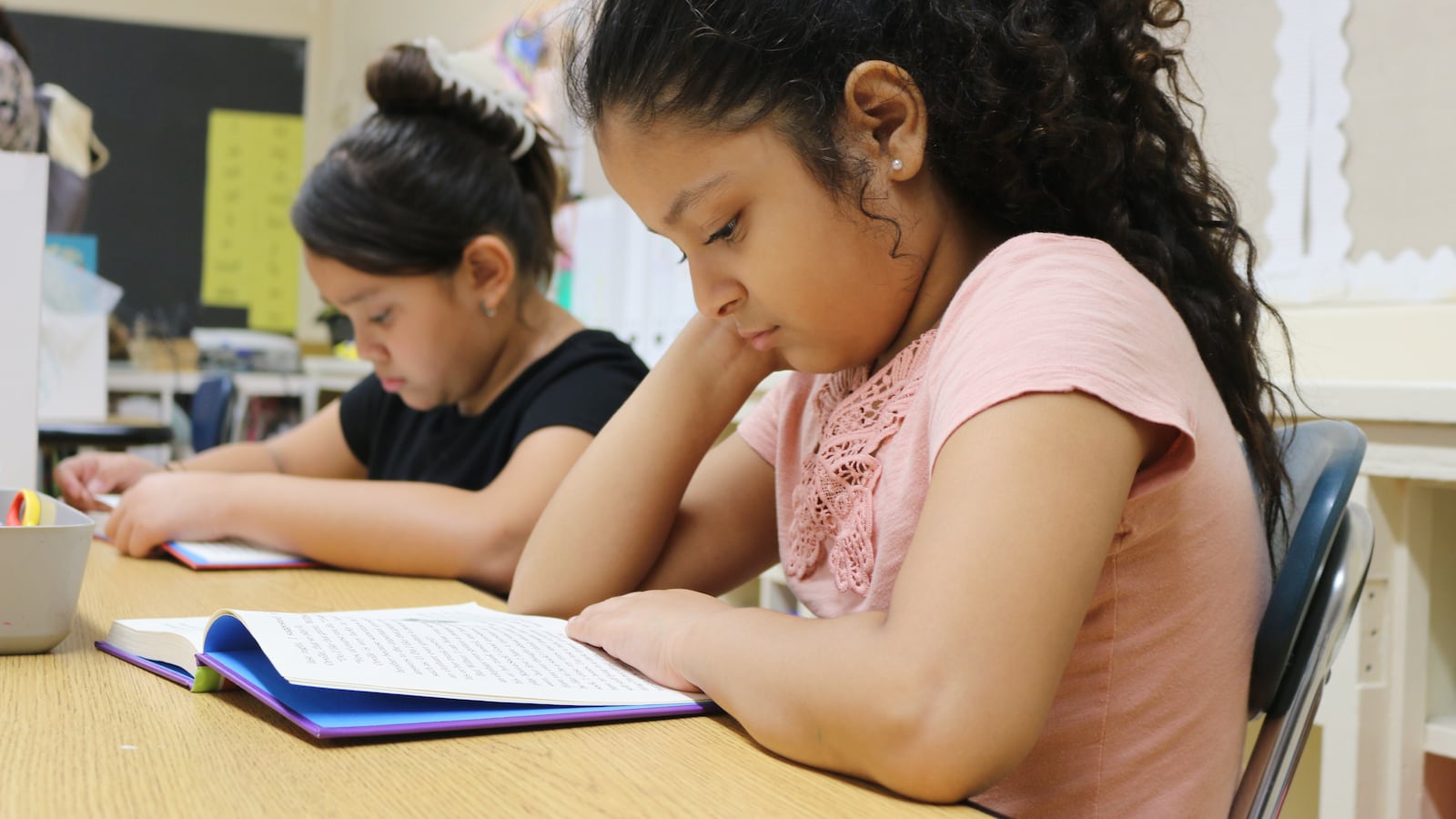This is part of an ongoing collaborative series between Chalkbeat and THE CITY investigating learning differences, special education, and other education challenges in city schools. Sign up for Chalkbeat New York’s daily newsletter and THE CITY’S Daily Scoop newsletter to keep up with our reporting.
Mayor Eric Adams has made dyslexia screening a centerpiece of his education agenda, often citing his own reading challenges as a motivation for more intensive testing.
He’s even suggested every student is being assessed.
“We’re the first city of this size to have dyslexia screening for all of our children,” Adams said last November.
New York City began screening most children for reading challenges just before Adams took office in response to pandemic-related academic concerns. Adams subsequently launched a program that uses a second round of screeners for students who are struggling, to identify whether they are at risk of dyslexia.
But the effort has reached a fraction of kids across the five boroughs thus far.
About 1,500 students across 133 schools were assessed for risk of dyslexia last school year, according to city Department of Education figures obtained by THE CITY and Chalkbeat.
Officials say they are planning to use those screeners more widely this school year, promising to expand to all elementary schools serving grades K-5 and 50 middle and high schools.
Dyslexia screening is popular with many advocates, parents, and elected officials who have long argued that too many struggling readers have fallen through the cracks. Conducting more rigorous testing could help identify students before they fall far behind, they argue, and keep parents from having to arrange their own pricey assessments and tutors to help their children catch up, a major equity concern.
Identifying students who are struggling can also spur known remedies, particularly structured, sequenced literacy instruction that is phonics-based.
But multiple literacy experts said the secondary tests — which flag students who are at risk of dyslexia rather than offering a specific diagnosis — don’t reveal much beyond what the first set of tests already show.
Of the 1,000 children in elementary school who were given the secondary assessment, 95% of them were identified as being at risk of dyslexia — suggesting schools already had a clear sense of which students were struggling. (In middle and high school, about 80% of students were flagged for extra help by the additional screeners.)
More important, experts said, is ensuring teachers have the tools they need to figure out why a student is struggling and to intervene.
“Teachers already know who needs more help,” Adrea Truckenmiller, an associate professor at Michigan State University who has studied literacy screening, said of the second layer of testing. “What they need to do is figure out what to teach the kids the next day, and this information is not really giving them that.”
Jonah Allon, a City Hall spokesperson, defended the secondary screening, saying it is part of “the most comprehensive approach to supporting dyslexic students in our city’s history.”
While the initiative’s expansion “will not happen overnight,” Allon wrote in an email, “Mayor Adams laid out an aggressive plan to bring this screening to all New York City students, and we are executing that plan right now.”
Education department officials said they were paying close attention to schools that are part of the city’s sweeping new literacy curriculum mandate — starting with nearly half of all elementary campuses this year. They will have access to educators who are trained to deliver the screening and provide more individual help to address students’ reading challenges, said Carolyne Quintana, the Education Department’s deputy chancellor of teaching and learning.
“We need that kind of more targeted information — more specific information that a secondary screener gives you that those others don’t,” Quintana said

Who has been screened, and what happens next?
In the wake of the pandemic, New York City began to standardize regular screening in reading and math to track disruptions to student learning and help teachers intervene.
That effort began during Mayor Bill de Blasio’s final year in office. Last school year, roughly 500,000 students in kindergarten through 10th grade were given general literacy assessments spread throughout the year.
Teachers are supposed to use the results of those assessments to adjust their instruction and provide individualized help. The Adams administration added a secondary layer of screening for students who performed poorly on the first set of assessments at about 133 pilot schools. (Last year, schools used Acadience Rapid Automatized Naming and Normed Spelling Measure for kindergarten and first grade students, and Acadience Oral Reading Fluency for students in grades two and up.)
Overall, 1,500 students received secondary screening across those schools, with 1,350 identified as being at risk of dyslexia. That’s about 2% of the 63,000 students enrolled across those campuses. Teachers were trained on administering the screenings and on interpreting the results, as well as on providing extra support, department officials said.
Students who were flagged by the secondary screeners should receive four days per week of 30- to 45-minute sessions of “explicit, systematic, evidence-based reading instruction” for the students deemed at risk, according to an Education Department spokesperson. Students not flagged by the secondary screeners but who are still struggling with reading are eligible for 30-minute sessions three days a week.
At P.S. 125 in Harlem, which has given teachers intensive training to address reading challenges, Principal Yael Leopold said the school uses a range of assessments and observations to determine why a student is struggling — a process that isn’t always straightforward.
“Maybe a child’s not hearing sounds correctly,” she said. “For another, it could be vision. For another, it’s their processing or their expressive language. I mean, there’s a million reasons why a child may struggle — and so that’s where we put all of our heads together.”

The school typically provides students who need extra help with small group instruction in their regular classrooms for about four weeks at a time instead of pulling them out for special sessions. Leopold said that keeps children from feeling like they’re being singled out.
“Children felt still part of the classroom community,” Leopold said. “They’re like, ‘I’m a great reader — I’m making improvement.’ And that’s really important to us.”
Experts say the tests aren’t worth it, but politicians push for more
Experts who are familiar with the secondary screeners stressed that they flag students for risk of dyslexia — rather than offering a more formal diagnosis — and generally aren’t much more sensitive than the first round of screening.
“This notion of ‘Let’s test them again and see if they need more’ — I’m not sure that actually buys you a whole lot,” said Timothy Shanahan, a professor at the University of Illinois, Chicago, who has written about the research on literacy screening. “If you say a kid is dyslexic, that doesn’t tell me at all what he needs,” he added. “It’s really a whole set of different disabilities all kind of lumped together.”
The screeners the city is using to identify students at risk of dyslexia identify broad issues like challenges with spelling or decoding words that can predict other reading problems, including dyslexia, Shanahan said. But they aren’t detailed enough to give educators a roadmap of what specific instructional tweaks might help.
Shanahan and others said the main downside to the additional screening is potentially taking time away from instruction. But they generally said it isn’t harmful and may signal to advocates and parents that the city is serious about addressing literacy deficits.
For Naomi Peña, a longtime public school parent leader who has four kids with dyslexia, the shift in how the mayor has placed struggling readers squarely at the forefront of the city’s efforts represents a sea change.
“As long as I’ve been in the public school system, the last two years is honestly the first time this ever has been discussed,” said Peña. “It’s unfortunate that it took someone who is dyslexic finally to become mayor and be in a position of power to want to center it, but this is where we are.”
The administration has won praise from many experts for focusing on literacy and requiring elementary schools to begin using curriculums that officials say are more aligned with research on how children learn to read. The administration has also launched some smaller-scale efforts, including more intensive training programs at a handful of schools and a first-of-its-kind district school focused on students with dyslexia and other print-based learning disabilities.
Additional screening for dyslexia is also popular with many elected officials who see the measure as addressing a significant equity issue.
State Assembly members Jo Anne Simon and Robert Carroll of Brooklyn have been vocal proponents of providing greater support for students with dyslexia and embraced the mayor’s efforts. They said that while the number of students who have been screened is low, the ball is moving in the right direction.
“Systematizing anything in a school system takes time, and in a large school system it’s going to take significant time,” said Simon, a former disability rights attorney.
Carroll said the city’s efforts are well-meaning but that fully implementing the program in every school could take years. He said with that trajectory, a more specific plan for getting there needs to be shared publicly.
Adams and schools Chancellor David Banks created a Dyslexia Task Force that was charged with producing a policy paper on the city’s “vision and approach to supporting students at risk of and/or living with dyslexia.” Though the report was set to be released in August 2022, Education Department officials did not provide a copy or explain the delay.
“At least we’re moving in the right direction,” said Carroll, who was diagnosed with dyslexia as a child. “We’re talking about it. I think they are sincere in trying to solve problems. I think it’s how do we perfect it, how do you scale it?”
Alex Zimmerman is a reporter for Chalkbeat New York, covering NYC public schools. Contact Alex at azimmerman@chalkbeat.org.

